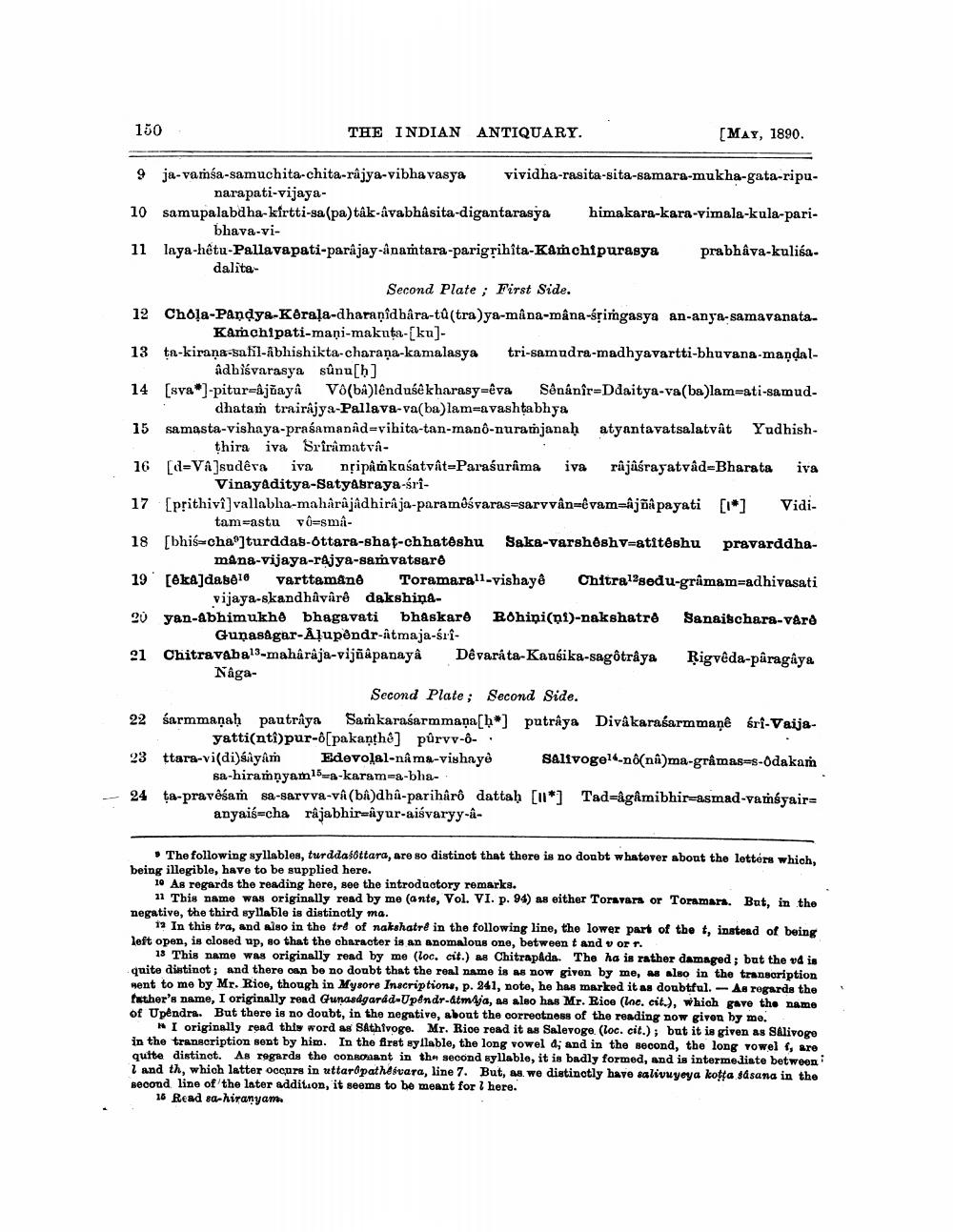________________
150
THE INDIAN ANTIQUARY.
SMAY, 1890.
9 ja-vamsa-samuchita-chita-rajya-vibha vasya vividha-rasita-sita-samara-mukha-gata-ripu
narapati-vijaya10 samupalabdha-kirtti-sa(pa) tâk-avabhâsita-digantarasya himakara-kara-vimala-kula-pari
bhava-vi11 laya-hetu-Pallavapati-parajay-anamtara-parigrihita-Kanchipurasya prabhava-kulisadalita
Second Plate ; First Side. 12 Chola-Pandya-Kerala-dharanidbâra-tû(tra)ya-mana-mana-śpingasya an-anya-samavanata
Kamchipati-maņi-makuta-[ku]13 ta-kirana-safil-abhishikta-charana-kamalasya tri-samudra-madhyavartti-bhuvana-mandal
adbiśvarasya sûnu[h] 14 (sva-pitur-ajõaya V(ba)lênduśê kharasyreva Sônánir=Ddaitya-va(ba)lam-ati-samud
dhatam trairajya-Pallava-va(ba) lam=avashtabhya 15 samasta-vishaya-prasamanid-vihita-tan-mano-nuramjanah atyantavatsalatvật Yudhish
thira iva Srirâmatva16 [d=VA]sudêra iva npiparkośatvat=Parasurima iva râjaśrayatvad-Bharata iva
Vinayaditya-Satyapraya-sri17 [prithivi]vallabha-mahârâjâdhiraja-paramèśvaras=sarvvân-êvam=âjõâ payati [1] Vidi
tam=astu vô=sma18 [bhischa"]turddas-Ottara-shat-chhatëshu Saka-varsh shv=atitéshu pravarddha
mana-vijaya-rajya-samvatsard 19 [ka]dabo16 varttamând Toramarall-vishayê Chitralsedu-grâmamadhivasati
vijaya-skandhavarê dakshina20 yan-abhimukho bhagavati bhaskarê Rohini(01)-nakshatro Sanaischara-vård
Gunasagar-Åļupendr-Atmaja-sri21 Chitravabal3-mahârâja-vijõâpanaya Dêvaráta-Kausika-sagôtrâya Rigveda-pâragâya Någa
Second Plate; Second Side. 22 śarmmaņah pantrậya Sam karaśarmmaņa[h*) putrâya Divakaraśarmmaņê śrf-Vaija
yatti(nti)pur-[pakanth8] půrvv-Ô-. 23 ttara-vi(di)siyam Edevolal-nâme-vishaye Salivogel-nô(nâ)ma-gråmasas-Odakaṁ
sa-hiramạyam 15-a-karam-a-bha24 ta-pravēšam sa-sarvva-va (badha-parihêrô dattah [11*] Tad-agamibhir=asmad-vamsyair
anyais-cha rajabhirayur-aišvaryy-a
The following syllables, turddatottara, are so distinct that there is no doubt whatever about the letters which, being illegible, have to be supplied here.
10 As regards the reading here, see the introductory remarks.
11 This name was originally read by me (ants, Vol. VI. p. 94) as either Torsvars or Toramara. But, in the negative, the third syllable is distinctly ma.
12 In this tra, and also in the trd of nakshatra in the following line, the lower part of the t, instead of being left open, is closed up, so that the character is an anomalous one, between t and vor.
18 This name was originally read by me (loc. cit.) as Chitrapada. The ha is rather damaged; but the vd is guito distinot, and there on bo no doubt that the real name is as now given by me, as also in the transcription Hent to me by Mr. Rioo, though in Mysore Inscriptions, p. 241, note, he has marked it as doubtful. As regards the father's name, I originally read Gunasdgardd-Upendr-atmija, as also has Mr. Rice (Inc. cit.), which gave the name of Upendra. But there is no doubt, in the negative, about the correotness of the reading now given by mo.
NI originally read this word as Bethlvoge. Mr. Rice read it as Salevogo (loc. cit.); but it is given as SAlivoge in the transcription sont by him. In the first syllable, the long vowel d; and in the second, the long vowel , sro quite distinct. As regards the consonant in the second syllable, it is badly formed, and is intermediate between 1 and th, which latter occurs in uttardpathivara, line 7. But, as we distinctly have salivuyeya kogfa sasana in the second line of the later addition, it seems to be meant for l here.
16 Read 8a-hiranyama




